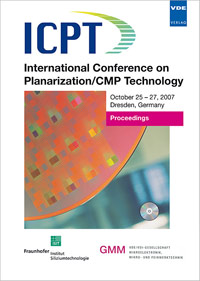Integrative Defect Density Reduction at STI CMP
Konferenz: ICPT 2007 - International Conference on Planarization / CMP Technology
25.10.2007 - 27.10.2007 in Dresden, Germany
Tagungsband: ICPT 2007
Seiten: 5Sprache: EnglischTyp: PDF
Persönliche VDE-Mitglieder erhalten auf diesen Artikel 10% Rabatt
Autoren:
Becker, Ralf; Tittes, Wolfgang; Peters, Stefan; Probst, Marc; Schulze, Daniel; Loesch, Stefan (Infineon Technologies Dresden GmbH & Co. OHG)
Boenicke, Andreas; Cwikla, Sebastian (Qimonda Dresden GmbH & Co. OHG, 01099 Dresden, Germany)
Inhalt:
Within this paper, the results of a detailed study about possible root causes for surface defects post CMP are summarized. Single surface defects in the STI oxide (rip-outs) are mainly caused by particles embedded during oxide deposition. The CMP process exposes these particles to the wafer surface and finally they are ripped out. The introduction of an optimized cleaning procedure enables the minimization of particles, embedded close to the surface and subsequently a general reduction in surface defects post CMP was observed. Using a pre-planarization etch process (oxide reverse etch) in order to ensure sufficient planarization after STI-CMP results in a high local HDP topology at the boundary exposed / unexposed SiO2. So-called dent defects are observed at the active area close to this boundary. The dent defects are eliminated by reducing the HDP topology, indicating that they are generated by breaking off of the oxide during the initial phase of the CMP process. Finally, the impact of different tool types on the defect density level was investigated and it was found that a significant reduction of dent defects and typical μ-scratches is observed only by exchanging the CMP equipment.


